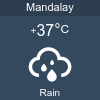Mandalay
Maha Myat Muni Pagoda
- Details
- Hits: 5075
 Maha Myat Muni Pagoda
Maha Myat Muni Pagoda
info It is the most revered Buddha image in Mandalay. It is also known as the Maha Myat Muni (မဟာမုနိဘုရားကြီး), or Phaya Gyi.
It is the most ancient Buddha image in Myanmar. It was cast in the life-span of Lord Buddha in the seated posture of relaxed deportment, namely Bumi Phasa Mudras, symbolic of His Conquest of Mara.
monetization_on Entry Fees: n.a.
watch_later Operation hours: 6:00 - 20:00
hourglass_full Time needed: Approximately 2 hour
visibility Virtual Tour
You can view 360°x360° view photosphere of this tourist site below. Click and drag, to move up, down, or around.
{streetview}21.9519594,96.0785032{/streetview}
In B.C 123, in the reign of King Sanda Thuriya, Monarch of Rakhine-Dharyawaddy carry the image reverently so as to enshrine it at the present site. It took four months to carry the image reverently across the Rakhine Yoma Ranges, by inland route and by waterway a tough and rough journey indeed. The height of the Maha Muni Buddha Image is 8 Cubits and 1 Maik ( 3.83m ). The altar is 2.13m high. There, 2 bronze Siamese images, 3 bronze lion images and 1 bronze three headed Ayeyawun elephants are housed and displayed in the precinct on the left side of the northern exit passage. Whoever visits Mandalay from local areas or from abroad unfailingly come and pay homage to the Maha Muni Buddha Image.

The Buddha image is covered with gold and the coating of gold thickness is 5.9 in
In the precinct of the Phayagyi is located the " Maha Buddha-Win Beikman ", the Museum of the Life of Buddha. It is a many-tiered building with Myanmar architectural finials. It houses a scenic map showing in old and current terms the spread of Theravada Buddhism, centered in central India, Buddha's birthplace, famous religious edifices in various lands, the routes of Lord Buddha on itinerary, and the routes of King Asoka's sending Buddhist missions to nine regions of nine countries in A.D 3rd century. Illustrations are displayed, which indicate the Four Noble Sites of Lord Buddha, namely, His birthplace, the site where He attained the Enlightenment, the site where he passed away.
The Buddha Images, representing various countries where Buddhism prospers well, and the Buddha Images revered through successive eras are exhibited in the forms of photographs, paintings and sculptures. Not only Buddhists but also foreigners studying Buddhism pay a visit to this museum. On the left side of the eastern passage, in the precinct of the pagoda, is the Sanctuary Pond of Tortoises and on the right side, the Sanctuary Pond of Fish.

The Image has a golden crown which is decorated with diamonds, rubies and sapphires

Mahamuni Pagoda

A large crowd of devotees in the prayer hall everyday

The early morning ritual of washing the Face of Maha Muni Image

Many shops in the passage to Pagoda
The Large Bronze Figures
The large Bronze Figures were brought to Myanmar from Thailand by King Bayintnaung Kyaw Htin Nawrahta in 1563 A.D. when he gained a victory over the enemy in Thailand. After the downfall and destruction of Hanthawaddy (Myanmar) in 1598 when the Thai King Byanarit attacked Taungoo in 1599, the Rakhine King fought from the Myanmar side. In that war, the Thai King was defeated. As he owed a debt of gratitude to the Rakhine King, the King of Taungoo presented the Rakhine King with various treasures including the large Bronze Figures.
In 1784, during the reign of King Bodawphaya, the Crown Price brought back the great Maha Muni Image on his victorious march from Danyawaddy in Rakhine. Along with the Maha Muni Image, the price also brought back to Myanamr kingdom those Bronze figures as spoils of war. That is why we see them here today.
From the historical records of world's researchers, we learn that these Bronze Figures were originally brought over to Thailand from the great Angkor Wat Buddhist Temple in Cambodia.
Three bronze lions statues, a three-headed elephant known as Airavata, and two warriors in the form of Shiva are displayed in the northern end of the pagoda compound. Devotees believe that the statues have healing powers to rub a particular part of the body against the statues to cure themselves of various illness.

Large bronze statues believed to have healing powers when rubbed

A three-headed elephant known as Airavata
build Year established: 1785
directions Directions:
place Location: 82nd street, Mandalay, Myanmar
local_phone Phone: n.a.
email Email: n.a.
public Website: n.a.
local_taxi Estimated taxi fare: n.a.
directions_bus Bus directions: n.a.
directions_railway Train directions: n.a.
map See map below:
help_outline Get a free quotation for a Myanmar tour to visit this place.
grade Give a star-rating on this place or write a FB comment below:







